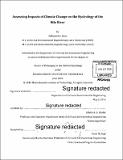| dc.contributor.advisor | Elfatih A. B. Eltahir. | en_US |
| dc.contributor.author | Siam, Mohamed S | en_US |
| dc.contributor.other | Massachusetts Institute of Technology. Department of Civil and Environmental Engineering. | en_US |
| dc.coverage.spatial | fl----- | en_US |
| dc.date.accessioned | 2016-09-13T19:26:04Z | |
| dc.date.available | 2016-09-13T19:26:04Z | |
| dc.date.copyright | 2016 | en_US |
| dc.date.issued | 2016 | en_US |
| dc.identifier.uri | http://hdl.handle.net/1721.1/104328 | |
| dc.description | Thesis: Ph. D., Massachusetts Institute of Technology, Department of Civil and Environmental Engineering, 2016. | en_US |
| dc.description | Cataloged from PDF version of thesis. | en_US |
| dc.description | Includes bibliographical references (pages 179-194). | en_US |
| dc.description.abstract | The human population living in the Nile basin is projected to double by 2050, approaching one billion. The increase in water demand associated with this burgeoning population fuels an ongoing water conflict between the riparian countries. Uncertainty regarding potential future changes in the flow of the Nile River as a result of climate change adds further stress to this critical situation. In this thesis, we investigate the impacts of climate change on hydrology and climate of the Nile basin. In particular, we predict and explain the future changes in interannual variability and long-term mean of the flow in Nile river. We analyze observations on recent change in the flow regime. First, we examine the role of El Niño Southern Oscillation (ENSO) in shaping the interannual variability of the flow in the Nile river. We document an association between variability of ENSO and interannual variability in the flow of the Nile river. We provide a physically-based explanation of this teleconnection. Then, we build on this teleconnection and future predications regarding the frequency of El Niño and La Nina events to project enhancement in future variability of the flow in the Nile river. Second, an improved version of the MIT Regional climate model (MRCM) is used to investigate the future changes in the long-term mean flow in the Nile river. The new version of MRCM includes new parameterizations of large scale cloud and rainfall developed as part of this thesis, which significantly improved the simulation of clouds coverage and radiation at the surface under current climate conditions. The updated version of the model is forced with modified lateral boundary conditions and greenhouse gas concentrations that are assumed to describe future conditions. The impacts on the rainfall over the basin due to local and regional changes in concentration of atmospheric gases are compared to those due to global changes in the humidity and temperature. The numerical simulations using MRCM suggest that increasing humidity at the lateral boundaries due to global processes would enhance the large scale rainfall, particularly during the rainy season. However, air temperature becomes warmer aloft due to the same global processes, which would tend to stabilize the atmosphere and reduce convective rainfall. On the other hand, increasing the concentration of greenhouse gases at local and regional scales would destabilize the vertical profile of air temperature, by increasing the air temperature in the middle and lower atmospheric layers, and hence would enhance convective rainfall. Based on the conclusions of this thesis, the long-term mean and standard deviation of the annual flow in the Nile river are projected to increase for the future period (2000-2100) compared to the past period (1900-2000) by approximately 15% and 50%, respectively. Although the increase in long-term mean of the annual flow should slightly reduce the water stress in the Nile basin, additional water storage capacity in the basin would be needed in order to benefit from the expected additional water in the future. | en_US |
| dc.description.statementofresponsibility | by Mohamed S. Siam. | en_US |
| dc.format.extent | 229 pages | en_US |
| dc.language.iso | eng | en_US |
| dc.publisher | Massachusetts Institute of Technology | en_US |
| dc.rights | M.I.T. theses are protected by copyright. They may be viewed from this source for any purpose, but reproduction or distribution in any format is prohibited without written permission. See provided URL for inquiries about permission. | en_US |
| dc.rights.uri | http://dspace.mit.edu/handle/1721.1/7582 | en_US |
| dc.subject | Civil and Environmental Engineering. | en_US |
| dc.title | Assessing impacts of climate change on the hydrology of the Nile River | en_US |
| dc.type | Thesis | en_US |
| dc.description.degree | Ph. D. | en_US |
| dc.contributor.department | Massachusetts Institute of Technology. Department of Civil and Environmental Engineering | |
| dc.identifier.oclc | 958280378 | en_US |
